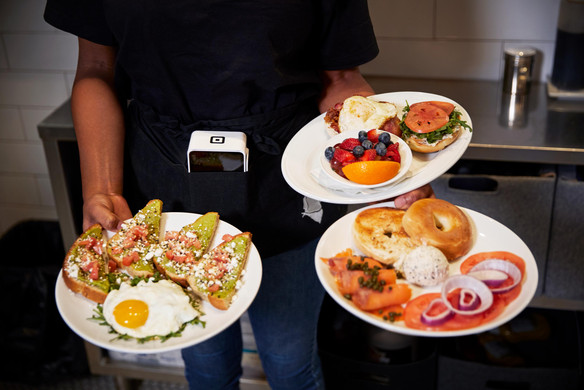Table of contents
For many restaurant owners, growth is a top priority. But in order to grow, your business needs to be flexible to evolving consumer behavior. Sometimes that takes rethinking your restaurant business model.
Take Woon Kitchen, a homestyle Chinese restaurant, for example. When the restaurant first launched, founder Keegan Fong wanted to focus on in-house dining, believing it was essential for creating a memorable customer experience. However, consumer behavior changed after the pandemic, prompting the team to go online. “We always wanted online ordering. That’s the future,” Keegan Fong explained in a conversation with Eric Wareheim for the Square video series, “Running a Restaurant is No Joke.” “But the first year we really wanted to bring people into the restaurant and experience it here first. Once the pandemic [hit], we obviously had to fast forward that timeline again.”
With the help of Square tools, Fong quickly built an online ordering profile and introduced wine delivery — decisions that proved to be lifesaving. “I built the online site literally in a day,” he shared. “And then, we launched wine ordering the next day… That saved us.”
Fong’s experience underscores the importance of thinking beyond the counter and building a flexible business that adapts to new dynamics. If growth is on your radar, here are the key strategies that can unlock more profit for your restaurant in 2025 and beyond.
Innovative Strategies for Growing Your Restaurant Business
These actionable strategies can help boost revenue, reduce costs, and maximize profitability.
1. Explore new revenue streams.
Expanding your restaurant’s income streams is one of the most effective ways to drive growth. By introducing new offerings, you can attract new customers, retain existing ones, and optimize profitability. Ninety percent of owners surveyed in the Square Future of Restaurants report intend to start up new revenue opportunities outside their core offerings. The good news is that consumers are on board with the idea — 40% of customers say they would love to try a new type of offering from a business known for something else.
New offerings can attract different customers with specific preferences. For example, introducing a line of vegan dishes might bring in more health-conscious diners. Beyond attracting new customers, introducing new products or services like private dining or retail merchandise can give existing customers a reason to come back and try something different. Overall, this helps to boost customer retention and frequency of visits.
Before you add a new offering to your menu, engage with your customers to understand their needs and wishes. It can be best to work with products and services that aren’t too far off from those your restaurant is already known for. It’s equally important to leverage your restaurant data when deciding what to sell. By starting with manageable additions, you can gather feedback, refine your approach, and decide which ideas resonate most with your customers.
If you’re looking for inspiration, borrowing ideas from outside the food industry can lead to breakthroughs. For example, some restaurants have adopted subscription models, a concept popularized by the software industry, to offer meal kits or exclusive dining memberships. Eric Wareheim confirms the benefit of this approach. “In my business, I’ve received some of the best advice from people outside the entertainment industry,” he noted. Alvin Cailan, chef and owner of burger restaurant Amboy, agrees. “People are so deep in the food trenches that they can’t think outside the box. But when someone from the outside looks in, it’s like, ‘Wow, I never thought of it that way.’”
Online and mobile ordering platforms are essential when starting up new revenue streams. For example, customers who may not have time to dine in can still order food for pickup or delivery, expanding your business’s reach and sales potential. Plus, digital tools provide valuable data on customer preferences and behavior. This information can be used to tailor marketing efforts, adjust menu offerings, and optimize pricing strategies, which can drive further growth.
Once you’re ready to experiment, Square makes it easy to manage new initiatives without disrupting your core service. Whether you’re selling branded T-shirts, booking catering gigs online, or offering meal kits through an online store, Square solutions can help you manage it all seamlessly. For example, eCommerce data from your Square site integrates directly into your point-of-sale system, giving you a clear overview of your business performance across all channels. By tracking the success of these initiatives, you can decide which ideas are worth incorporating as permanent parts of your brand.
2. Transform your business concept.
Once you’ve tested new offerings and identified what works, consider adopting successful ideas as parts of your business concept. Why stop at being just a diner or wine bar when you can be both or more?
A multi-concept strategy enables you to adapt to different moods, times, and customer needs. You could operate as a coffee shop during the day and transform into a cocktail lounge at night or serve a lively brunch crowd on weekends while offering intimate private dining experiences on weeknights.
You can also take a multihyphenate approach, a growing trend among innovative restaurants. Examples include a Jewish-Japanese restaurant with its own retail line, a cat-themed café featuring adoptable cats, and a sandwich shop that offers catering, wholesale, and nationwide dropshipping. Flexible setups like these help you maximize your space and make the most of your resources.
And the best part is that you don’t need to tear down walls or hire extra staff to make it happen. With tools like the flexible Square point-of-sale (POS) system, you can manage transitions seamlessly, switching concepts without added complexity.
Here are other ways Square can support your multi-concept ideas:
-
A real-time inventory management tool keeps your inventory updated across all concepts, whether you’re selling pastries or chef specials. This ensures you never run out of key items and can plan purchases effectively, even as you shift offerings.
-
Flexible payment solutions adapt to any concept, from counter service to tableside payments. With handheld devices and QR code ordering, you can effortlessly accommodate different service styles.
-
Team management tools allow you to schedule staff and assign roles based on the concept you’re running, ensuring you have the right team in place for every shift.
-
Reporting tools provide insights across all your concepts, helping you understand what’s performing best and when. Whether it’s tracking coffee sales in the morning or wine pairings at night, you’ll have the data to optimize each part of your business.
As you experiment with new ideas or make lasting changes to your concept, strategic and consistent marketing is crucial for increasing sales. And it doesn’t have to be difficult. Tools like Square Marketing allow you to automate outreach while ensuring that messages are personalized and tailored to specific customer segments.
CRM software like Square Customer Directory helps you manage interactions with current and potential customers by storing information such as customer contact details, purchase history, and communication records. You can use this data to tailor marketing messages, predict customer behavior, and personalize interactions, making your marketing efforts more targeted and efficient. By combining creativity with the right technology, you can evolve your restaurant into a multi-faceted, future-proof business that delights customers and drives revenue.
3. Optimize labor costs with smart technology.
Labor costs can take a big bite out of your restaurant’s profits, especially when you’re experimenting with your concept or adding new income channels. The good news is that you don’t need an entire staff to be an efficient and profitable business. “If you have good product, like good meat, good brand, good cheese, you have something that you can scale. Once you nail that, it’s operationally how you’re training people, all that stuff,” explained chef Cailan.
With the right technology, you can do more with less, keep more revenue in your pocket, and ensure customers stay happy. In fact, 76% of customers want their favorite restaurants to use automation technology in at least one area to help enhance efficiency, including taking payments, making reservations, and tracking item availability.
If you’re looking for solutions, here are some essential tools to help you cut labor costs and boost efficiency.
-
Self-service kiosk: You can set up a self-service ordering solution and keep the front and back of house seamlessly in sync. Both sides get real-time menu updates and sales data without the need for third-party software. One kiosk can handle the workload of multiple cashiers, especially during peak hours.
-
Handheld POS: The ultimate line-busting gadgets are handheld point-of-sale devices like Square Terminal. These devices allow servers to take orders and process payments tableside, cutting down on time spent running back and forth to a stationary POS system. This means quicker table turnover and happier customers.
-
QR codes: QR code tools make contactless payments and online ordering easier and faster. Customers can scan, order, and even pay right from their phones, so you can deliver a great experience without hiring extra staff.
Building a flexible and profitable food business
Increasing your restaurant’s revenue in 2025 and beyond isn’t about working harder. It’s about working smarter. By adopting modern restaurant technology, you can optimize labor costs with kiosks and QR codes, diversify your revenue streams with eCommerce solutions, and transform your space into a multi-concept powerhouse. These strategies open up new possibilities to grow your bottom line while delivering exceptional customer experiences. With Square tools, you can stay ahead of the competition, adapt to evolving customer needs, and create a business that thrives in any environment.
![]()









